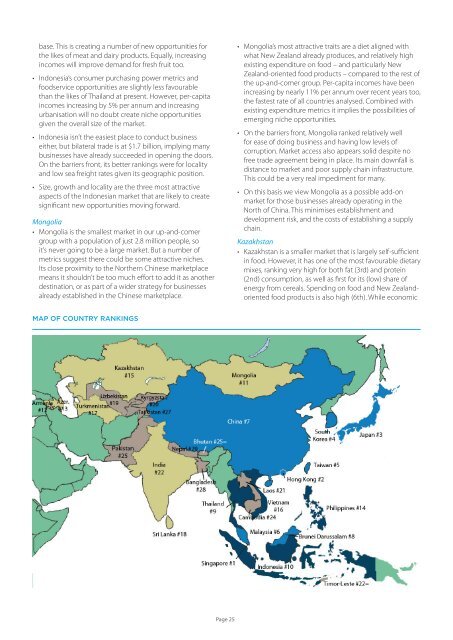New horizons alternative Asian markets – From OPPortUNITY to CONNECtivitY
1sxNzy1
1sxNzy1
Create successful ePaper yourself
Turn your PDF publications into a flip-book with our unique Google optimized e-Paper software.
ase. This is creating a number of new opportunities for<br />
the likes of meat and dairy products. Equally, increasing<br />
incomes will improve demand for fresh fruit <strong>to</strong>o.<br />
• Indonesia’s consumer purchasing power metrics and<br />
foodservice opportunities are slightly less favourable<br />
than the likes of Thailand at present. However, per-capita<br />
incomes increasing by 5% per annum and increasing<br />
urbanisation will no doubt create niche opportunities<br />
given the overall size of the market.<br />
• Indonesia isn’t the easiest place <strong>to</strong> conduct business<br />
either, but bilateral trade is at $1.7 billion, implying many<br />
businesses have already succeeded in opening the doors.<br />
On the barriers front, its better rankings were for locality<br />
and low sea freight rates given its geographic position.<br />
• Size, growth and locality are the three most attractive<br />
aspects of the Indonesian market that are likely <strong>to</strong> create<br />
significant new opportunities moving forward.<br />
Mongolia<br />
• Mongolia is the smallest market in our up-and-comer<br />
group with a population of just 2.8 million people, so<br />
it’s never going <strong>to</strong> be a large market. But a number of<br />
metrics suggest there could be some attractive niches.<br />
Its close proximity <strong>to</strong> the Northern Chinese marketplace<br />
means it shouldn’t be <strong>to</strong>o much effort <strong>to</strong> add it as another<br />
destination, or as part of a wider strategy for businesses<br />
already established in the Chinese marketplace.<br />
• Mongolia’s most attractive traits are a diet aligned with<br />
what <strong>New</strong> Zealand already produces, and relatively high<br />
existing expenditure on food <strong>–</strong> and particularly <strong>New</strong><br />
Zealand-oriented food products <strong>–</strong> compared <strong>to</strong> the rest of<br />
the up-and-comer group. Per-capita incomes have been<br />
increasing by nearly 11% per annum over recent years <strong>to</strong>o,<br />
the fastest rate of all countries analysed. Combined with<br />
existing expenditure metrics it implies the possibilities of<br />
emerging niche opportunities.<br />
• On the barriers front, Mongolia ranked relatively well<br />
for ease of doing business and having low levels of<br />
corruption. Market access also appears solid despite no<br />
free trade agreement being in place. Its main downfall is<br />
distance <strong>to</strong> market and poor supply chain infrastructure.<br />
This could be a very real impediment for many.<br />
• On this basis we view Mongolia as a possible add-on<br />
market for those businesses already operating in the<br />
North of China. This minimises establishment and<br />
development risk, and the costs of establishing a supply<br />
chain.<br />
Kazakhstan<br />
• Kazakhstan is a smaller market that is largely self-sufficient<br />
in food. However, it has one of the most favourable dietary<br />
mixes, ranking very high for both fat (3rd) and protein<br />
(2nd) consumption, as well as first for its (low) share of<br />
energy from cereals. Spending on food and <strong>New</strong> Zealandoriented<br />
food products is also high (6th). While economic<br />
MAP OF COUNTRY RANKINGS<br />
Page 25


